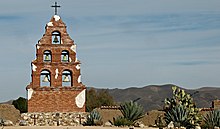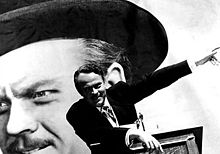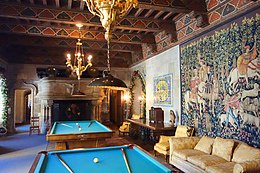Hearst Castle
Their guest list included many of the Hollywood stars of the period; Charlie Chaplin, Cary Grant, the Marx Brothers, Greta Garbo, Buster Keaton, Mary Pickford, Jean Harlow and Clark Gable all visited, some on multiple occasions.
"[20] George Hearst developed the estate somewhat, introducing beef and dairy cattle, planting extensive fruit orchards, and expanding the wharf facilities at San Simeon Bay.
[35] This led to work at Wyntoon and to a number of commissions from Hearst himself; an unexecuted design for a mansion at Sausalito, north of San Francisco, a cottage at the Grand Canyon, and the Los Angeles Examiner Building.
[b][18] In 1919, when he turned up at Morgan's office, Hearst was fifty-six years old and the owner of a publishing empire that included twenty-eight newspapers, thirteen magazines, eight radio stations, four film studios, extensive real-estate holdings and thirty-one thousand employees.
[36][37] He was also a significant public figure: although his political endeavors had proved largely unsuccessful, the influence he exerted through his very direct control of his media empire attracted fame and opprobrium in equal measure.
[42] Thomas Aidala, in his 1984 history of the castle, made a similar observation: "seated opposite each other, they would discuss and review work, consider design changes, pass drawings back and forth ... seemingly oblivious of the rest of the guests".
Among Hearst's guests were Calvin Coolidge, Winston Churchill, Charlie Chaplin, Cary Grant, the Marx Brothers, Charles Lindbergh, Jean Harlow and Clark Gable.
[46] Churchill described his host, and Millicent Hearst and Davies, in a letter to his own wife; "a grave simple child – with no doubt a nasty temper – playing with the most costly toys ... two magnificent establishments, two charming wives, complete indifference to public opinion, oriental hospitalities".
"[d][49][50] Weekend guests were either brought by private train from Glendale Station north of Los Angeles, and then by car to the castle, or flew into Hearst's airstrip, generally arriving late on Friday evening or on Saturday.
[57] Charlie Chaplin commented on the fare; "dinners were elaborate, pheasant, wild duck, partridge and venison" but also the informality, "amidst the opulence, we were served paper napkins, it was only when Mrs. Hearst was in residence that the guests were given linen ones".
Sherman Eubanks, whose father worked as an electrician at the castle, recorded in an oral history: "Mr Hearst would push a button and call up to the projectionist and say 'Put on Marion's Peg o' My Heart'.
[68][69] In February 1938, a plane crash at the San Simeon airstrip led to the deaths of Lord and Lady Plunket, who were traveling to the castle as Hearst's guests, and the pilot Tex Phillips.
[71][72][73][74] Having made his name with the Mercury Theatre production of The War of the Worlds in 1938, Welles arrived in Hollywood in 1939 to make a film version of Joseph Conrad's novel, Heart of Darkness for RKO Pictures.
The film tells the stories of Kane, a media magnate and aspiring politician, and of his second wife Susan Alexander, a failed opera singer driven to drink,[g] who inhabit a castle in Florida, filled with "paintings, pictures, statues, the very stones of many another palace – a collection of everything so big it can never be cataloged or appraised; enough for ten museums; the loot of the world".
[78] Told of the film's content before its release – his friends, the gossip columnists Hedda Hopper and Louella Parsons having attended early screenings – Hearst made strenuous efforts to stop the premiere.
[3] During the early years of construction, until Hearst's stays at San Simeon became longer and more frequent, his approval for the ongoing design was obtained by Morgan sending him models of planned developments.
[122] In the early years, the estate lacked water, its limited supplies coming from three natural springs on Pine Mountain, a 3,500 ft-high (1,100 m) peak seven miles (11 km) east of Hearst Castle.
[124] Water was of particular importance; as well as feeding the pools and fountains Hearst desired, it provided electricity, by way of a private hydroelectric plant, until the San Joaquin Light and Power Corporation began service to the castle in 1924.
[142] Morgan's staff were responsible for the cataloguing of those parts of Hearst's art collection which were shipped to California and an oral record made in the 1980s indicates the methodology used for furnishing the buildings at San Simeon.
[165] The doorway from the Central Plaza into Casa Grande illustrates Morgan and Hearst's relaxed approach to combining genuine antiques with modern reproductions to achieve the effects they both desired.
[176] These include four from a set celebrating the Roman general Scipio Africanus, designed by Giulio Romano, and two copied from drawings by Peter Paul Rubens depicting The Triumph of Religion.
[198] The ceiling of the bedroom is one of the best Hearst bought; Spanish, of the 14th century, it was discovered by his Iberian agent Arthur Byne who also located the original frieze panels which had been detached and sold some time before.
[202] The necessity of raising the roof to incorporate the study occasioned one of the few instances where Hearst hesitated, "I telegraphed you my fear of the cost...I imagine it would be ghastly", and Morgan urged further changes and expense.
[221] His deconstruction and removal of the 14th century Bradenstoke Priory in England led the Society for the Protection of Ancient Buildings to organize a campaign which used language so violent that its posters had to be pasted over for fear of a libel suit.
[232] In the courtyard of Casa del Monte is one of a total of nine Roman sarcophagi collected by Hearst, dated to 230 AD and previously held at the Palazzo Barberini, which was acquired at the Charles T. Yerkes sale in 1910.
[245] Hearst was always interested in pieces that had historical and cultural connections to the history of California and Central and Latin America; the North Wing contains two Peruvian armorial banners.
[257] Morgan designed the pedestrianized pavement with great care, to create a coup de théâtre for guests, desiring "a strikingly noble and saississant effect be impressed upon everyone on arrival".
The region is sparsely populated because the Santa Lucia Range abuts the Pacific Ocean, which provides dramatic vistas but offers few opportunities for development and hampers transportation.
[107] The unfinished, and unresolved, rear façade of Casa Grande has been the subject of particular negative comment; Carleton Winslow and Nicola Frye, in their history from 1980, suggest the flanking north and south wings "compete rather disastrously" with the central doge's suite block.
[ag][302] Of Morgan's building, its stock has risen with the re-evaluation of her standing and accomplishments, which saw her inducted into the California Hall of Fame in 2008,[303] become the first woman to receive the American Institute of Architects Gold Medal in 2014,[ah][305] and to have an obituary in The New York Times as recently as 2019.























